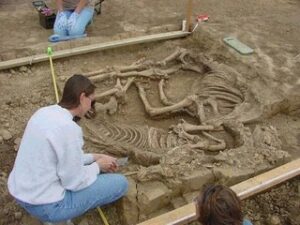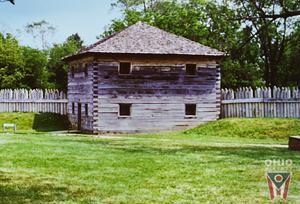 Regular readers of the OHS Archaeology Blog certainly will be aware of how archaeology can make important contributions to our understanding of historic events. Our investigations at Pickawillany, for example, are fleshing out a number of remarkable details about a site of great importance to our history, but for which there is very little conventional “history” that is, contemporary written records or accounts describing it. Another example of archaeology adding intimacy to the written accounts of an important historical event is the discovery of two forgotten casualties of the War of 1812 during excavations at Fort Meigs State Memorial in Wood County. In the summer of 2001, OHS archaeologists directed by Bill Pickard uncovered the remains of two horses, a large draft horse and a smaller cavalry horse that had been buried together in a shallow hole about 250 feet from the walls of the fort.
Regular readers of the OHS Archaeology Blog certainly will be aware of how archaeology can make important contributions to our understanding of historic events. Our investigations at Pickawillany, for example, are fleshing out a number of remarkable details about a site of great importance to our history, but for which there is very little conventional “history” that is, contemporary written records or accounts describing it. Another example of archaeology adding intimacy to the written accounts of an important historical event is the discovery of two forgotten casualties of the War of 1812 during excavations at Fort Meigs State Memorial in Wood County. In the summer of 2001, OHS archaeologists directed by Bill Pickard uncovered the remains of two horses, a large draft horse and a smaller cavalry horse that had been buried together in a shallow hole about 250 feet from the walls of the fort.
 The OHS archaeologists were investigating the area to be disturbed by the planned construction of the museum at the site when the horse bones were first uncovered. After several weeks of careful excavation, assisted by several local volunteers, the OHS team was able to begin their forensic examination and learn the stories of these “prince and pauper” horses.
The OHS archaeologists were investigating the area to be disturbed by the planned construction of the museum at the site when the horse bones were first uncovered. After several weeks of careful excavation, assisted by several local volunteers, the OHS team was able to begin their forensic examination and learn the stories of these “prince and pauper” horses.
The large draft horse was wearing rough horseshoes, two of which were mismatched. It appeared to have a broken front leg. We do not know how the leg came to be injured, but it would have meant the horse had to be put down. The smaller horse had only one horseshoe remaining and it was finer and smooth-bottomed. The other horseshoes apparently had been salvaged before the horse was buried for several bent horseshoe nails were found around its feet. This was probably a horse ridden by one of the dragoons stationed at the fort. This horse appears to have been severely wounded in battle. The archaeologists found a load of buckshot in the horse’s chest and abdomen and a .45 caliber musketball lodged along the side of its head. Neither wound would have been immediately lethal, but if it survived its wounds, this horse also would have had to be put down. Perhaps the musketball found resting along the head represents the shot intended to put the horse out of its misery. The horses were buried facing each other. Their legs were intermingled and their necks were crossed, almost as if they were embracing. Were they posed this way intentionally? We don’t know. They lived very different lives.
One probably pulled a wagon and the other carried a soldier into battle. But both horses died in the service of our country. Many horses died during the seiges of Fort Meigs. William Henry Harrison issued a General Order in 1813 directing the Quarter Master to immediately remove and bury “all the dead animals” adjacent to the fort. The OHS excavations revealed only one episode in a prolonged and bloody conflict, but it is a part of the story that is seldom told. Information about this horse burial is featured in the exhibits of the Fort Meigs Museum and education center. For information about how to get there and the hours of operation, call 1-800-283-8916, or visit the site’s webpage: https://www.ohiohistory.org/visit/browse-historical-sites/fort-meigs/. For more information about the Seiges of Fort Meigs and the War of 1812, see the articles on Ohio History Central: http://www.ohiohistorycentral.org/entry.php?rec=553.
